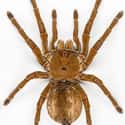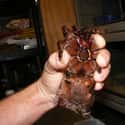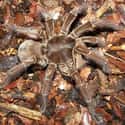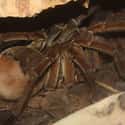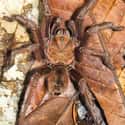-
(#1) It's The Most Massive Spider Species In The World
It should be no surprise a spider that can eat birds is huge. The Goliath is (quite literally) massive. It is the largest spider in the world in body size and mass. Its body length can reach 11.9 cm (about 4.5 inches) in length; some Goliath birdeaters have been known to reach lengths of 11 inches, which is about as big as a dinner plate.
Goliath birdeater leg span can reach 28 cm, and the spiders weigh around 175 grams, which is a little less than half a pound (what do you want, it's a spider, not an elephant). The only larger spider by any measure is the giant huntsman, which has a longer leg span.
-
(#2) They Can Regenerate Lost Limbs Through A Molting Process
Like many tarantulas, Goliath birdeaters molt past maturity, meaning they continually produce new skin and shed old skin, as do snakes. The process by which Goliath birdeaters molt can also be used to regenerate lost limbs.
If a Goliath birdeater loses a leg, it increases fluid pressure in its body to pop off part of its carapace, or the hard shell covering the animal. It then pumps fluid from its body to its limb to force old skin off and creates new skin in the shape of the lost limb, which is filled with fluid until it becomes a solid leg. The spider then regrows the lost part of its carapace. This process can take as long as several hours, and the spider exists in an vulnerable state, its exposed parts the texture of rubber, until it is full regenerated.
-
(#3) They Shoot Tiny Barbed Hairs From Their Abdomen As A Defense Mechanism
When threatened, Goliath birdeaters can shoot tiny, barbed hairs (called urticating hairs) from their body. These extremely tiny hairs irritate to the skin, and can get caught in the eyes, nose, and mouth to great agitation of the attacker; they are especially damaging to soft, exposed areas with mucous membranes, such eyes.
-
(#4) Males Die Not Long After Mating
Male Goliath birdeaters typically die a few months after mating, having fulfilled their biological function. The female spins a web, lays 50 to 200 eggs in that web, gathers the web into a ball, and carries it around. Carrying the egg sac makes Goliath birdeaters unique among tarantula species.
-
(#5) Like All Tarantulas, Their Eyesight Is Terrible
Despite what you may surmise from looking at them, Goliath birdeaters are not perfect killing machines. Like all tarantulas and most spiders, they have incredibly poor eyesight. To make up for this, tarantulas hunt by sensing vibrations on the ground. When they feel something, they pounce on their prey and subdue it with venom.
Tarantulas make up for poor eyesight by hunting at night, putting them on equal footing with anything that isn't an owl. Or Predator. But why would a tarantula hunt Predator?
-
(#6) It's A Species Of Tarantula
Goliath birdeater spiders are taxonomically classified as Theraphosa blondi. They belong to Arachnida Class, Aranea Order (spiders), Mygalomorphae Suborder, and Theraphosidae Family. The latter makes them tarantulas, a family of spiders containing at least 947 species. Tarantulas are typically large spiders with hair on their legs and abdomen and two tarsal (at the end of the their legs) claws.
They are burrowing creatures that pose no serious threat to humans and can live as long as 30 years in the wild.
-
(#7) Despite The Name, They Mostly Eat Worms
While it's true Goliath birdeaters attack and eat small birds, they rarely manage to catch avian prey in the wild. In fact, they subsist primarily on worms, supplemented with typical giant spider fare such as insects, lizards, frogs, toads, and even the occasional snake.
-
(#8) Children in Venezuela Hunt And Eat Goliath Birdeaters
The children of Venezuela's Piaroa tribe hunt their own food from an early age. One of their favorite treats are Goliath birdeaters. According to members of the tribe, the spiders taste very good.
-
(#9) Females Live For Decades, Males A Few Years
Female Goliath birdeaters have an average lifespan of 10 to 15 years but can live as long as 25 years in the wild. Males live three to six years, since they die not long after their first successful mating and reach sexual maturity at some point between the ages of three and six years. The longest a male has lived after mating is a year.
-
(#10) They Make Defensive Sounds Like Those Of A Rattlesnake
When threatened, Goliath birdeaters rub their legs together to make an intense hissing that sounds like a rattlesnake. The sound is meant to scare potential threats so the spider doesn't have to fight for its life.
-
(#11) Three New Species Of Birdeater Tarantulas Were Discovered In 2017
In March 2017, three new species of bird-eating spiders were discovered in the jungles of Peru, Ecuador, and Brazil by Caroline Sayuri Fukushima of the Sau Paulo Institute. The discoveries were part of a project to help better document and track tarantulas of the Avicularia genus, the classification of which Fukushima describes as "a huge mess."
These animals belong to a different genus than the Goliath birdeater, which makes you wonder how many giant birdeating tarantula species there are in the world.
-
(#12) They're Relatively Harmless To Humans
The Goliath birdeater really just wants to be left alone. The only time they attack humans is when threatened. If you keep your distance, you'll be fine. While Goliath birdeaters are venomous spiders, they usually won't use their venom on humans. If they do, at worst you'll suffer some pain and swelling; their venomous bite is likened to a wasp sting.
However, they usually deliver a dry bite, or one with no venom.
New Random Displays Display All By Ranking
About This Tool
Our data comes from Ranker, If you want to participate in the ranking of items displayed on this page, please click here.











